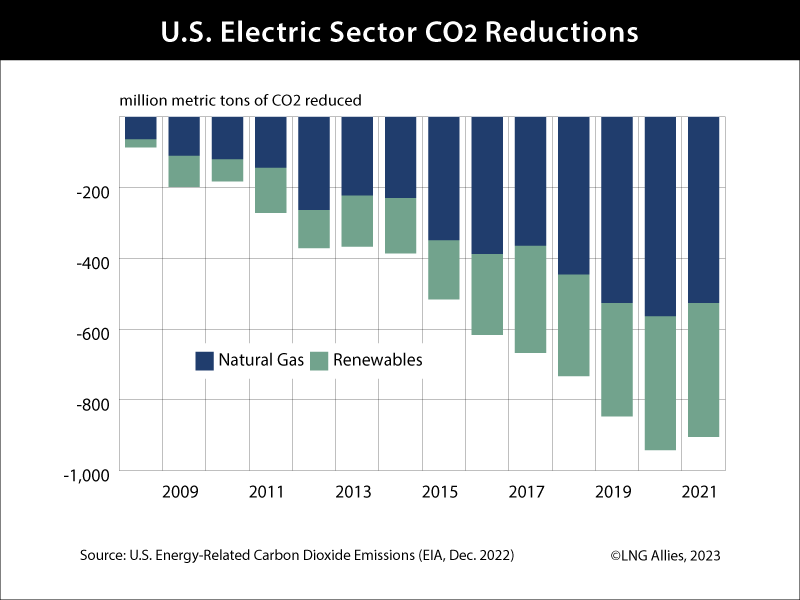Mitigating Climate Change
The most urgent and important challenge facing humankind is global climate change.
The earth’s climate is changing and there is broad agreement that carbon dioxide (CO2) and other greenhouse gas (GHG) emissions must be reduced to limit future temperature increases. There is not, however, consensus on how to achieve GHG reductions on a global scale.
Some argue that renewables (primarily wind and solar), electric vehicles, battery storage, and energy conservation can produce a “net zero” future without the need for continued reliance on nuclear power or natural gas. Others point out the practical limitations and enormous costs and challenges of a 100% renewables approach, especially in the next two or three decades.
However this debate plays out, it is clear that natural gas is much cleaner than coal for the generation of electricity:
We believe that the widespread deployment of renewables plus coal-to-gas switching in the power sector can produce the greatest immediate climate benefits and we know that the United States can supply natural gas—in the form of LNG—to nations that want to reduce their greenhouse gas emissions as rapidly as possible. This is the U.S. experience:
The “100% renewables” advocates argue that the GHG benefits of coal-to-gas switching are undercut by the fact that natural gas is mostly methane, which is itself a potent greenhouse gas. They argue that upstream methane leaks and flaring render natural gas “no better” than coal.
This argument has been disproved by nine life cycle assessments undertaken by government scientists, academic investigators, and other researchers since 2014. (*Citations below.) Nonetheless, methane leakage from oil and gas production is a serious problem that is being proactively addressed by individual companies and industry consortia.
Our Position on Climate Change:
- The earth is warming. The climate is changing. Humans are largely responsible. These are unassailable facts.
- We support the Paris Climate Agreement’s goals of limiting global warming to below 2°C above preindustrial levels. We also support efforts to limit the temperature increase to 1.5°C.
- We believe there is more than one viable pathway to address climate change, and we support any pathway to net zero greenhouse gas emissions by 2050 that includes natural gas as a compliment to energy conservation and renewables.
- Methane is a potent greenhouse gas that should be directly regulated. We support efforts to reduce and eventually eliminate oil and gas flaring and methane leaks.
*LNG Life-Cycle Assessments:
Vidas, H. (2020), Update to the Life Cycle Analysis of GHG Emissions for USLNG Exports, ICF for American Petroleum Institute.
Roman-White, S., Rai, S., Littlefield, J., Cooney, G., Skone, T. S. (2019). Life Cycle Greenhouse Gas Perspective on Exporting Liquefied Natural Gas from the United States: 2019 Update, National Environmental Technology Laboratory, U.S. Dept. of Energy.
Mallapragada, D. S.; Naik, I.; Ganesan, K.; Banerjee, R.; Laurenzi, I. J. (2019). Life Cycle Greenhouse Gas Impacts of Coal and Imported Gas-Based Power Generation in the Indian Context, Environ. Sci. Technol., 53, 539-549.
Kasumu, A.S.; Li, V.; Coleman, J.W.; Liendo, J.; Jordaan, S. (2018). Country-Level Life Cycle Assessment of Greenhouse Gas Emissions from Liquefied Natural Gas Trade for Electricity Generation, Environ. Sci. Technol. 52, 1735-1746.
Mallapragada, D.S., Reyes-Bastida, E., Roberto, F., McElroy, E. M., Veskovic, D., Laurenzi, I.J. (2018). Life Cycle Greenhouse Gas Emissions and Freshwater Consumption of Liquefied Marcellus Shale Gas Used for International Power Generation. Journal of Cleaner Production, 205, 672-680.
Raj, R., Ghandehariun, S., Kumar, A., Linwei, M. (2016). A Well-to-Wire Life Cycle Assessment of Canadian Shale Gas for Electricity Generation in China. Energy, pp. 642-652
Abrahams, L., Samaras, Griffin, M. W., Matthews, S. H. (2015) Life Cycle Greenhouse Gas Emissions From U.S. Liquefied Natural Gas Exports: Implications for End Uses, Environ. Sci. Technol. 49, 3237-3245.
Coleman, J., Kasumu, A. S., Liendo, J.; Li, V.; Jordaan, S. M. (2015). Calibrating Liquefied Natural Gas Export Life Cycle Assessment: Accounting for Legal Boundaries and Post-Export Markets, CIRL Occasional Paper No. 49; Canadian Institute of Resources Law.
Skone T. J., Cooney, G., Jamieson, M., Littlefield, J., Marriott, J. (2014). Life Cycle Greenhouse Gas Perspective on Exporting Liquefied Natural Gas from the United States, National Environmental Technology Laboratory, U.S. Dept. of Energy.


